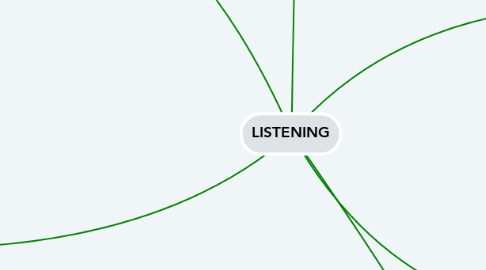
1. Raising strategy awareness in the modern foreign language classroom
1.1. Group discussions on the approach taken by students can also stimulate reflection
1.1.1. It is then crucial to further support this ever-developing awareness of listening strategies
1.1.2. Offering structured practice, where the focus is on the process as well as the product of listening
1.2. Listening from the Middle
1.2.1. Students to listen to a recorded piece of authentic conversation from the middle
1.2.2. Use referential clues from the discourse and background noise to infer information regarding its setting, context, mood and relationship between the interlocutors
1.2.3. Each of these pieces of information can act as indicators to trigger background knowledge.
2. Teaching culture to enrich background knowledge
2.1. An important requirement, then, for learning spoken English, is the acquisition of cultural knowledge
2.2. Teachers should include culturally-infused information as part of the course criteria
2.2.1. Teachers must also be acute to the fact that cultural diversity amongst English speaking countries can also play a role
2.3. The presence of cultural references is something inherent in any piece of discourse
2.4. Those cultural aspects will help them construct its meaning as well as acknowledge differences between their own culture and that of the target language
3. Top-down processing skills vs Bottom-Up processing skills
3.1. Dichtogloss
3.1.1. The objective of this exercise is “to demonstrate the guesswork involved in listening and encourage students to adjust their strategies
3.1.2. The Listening stage
3.1.2.1. Requires the students to listen once to a complete passage without taking notes
3.1.3. The Reconstruction stage
3.1.3.1. Requires groups of students to create as accurate a reconstruction of the text as possible
3.1.4. The Discovery stage
3.1.4.1. In order to better highlight the difficulties the students faced during the two preceding stages.
3.1.4.1.1. a) Students compare their text with the original, and attempt to classify the causes of mistakes
3.1.4.1.2. b) Assess the relative importance of their errors
3.1.4.1.3. c) listen again without reading the text, and assess their performance
3.1.5. Top-down processing skills seem to be a dominant tool when discussing how to improve learners’ listening strategies
3.1.5.1. Top-down processing is used by all listeners, it is not the ideal, and we should keep in mind that the learners’ ultimate aim is to rely less on contextual guesswork, and more on hearing what was actually said
4. The forgotten skill
4.1. 40% percent of our daily communication time is spent on listening. 35% percent being dedicated to speaking 60% percent devoted to reading and only 9% percent of our daily communication being occupied by writing.
5. Difficulties .
5.1. The identification of the words that constitute the oral discourse
5.2. Confusion due to words with different pronunciation
5.3. Identifying new wors causes stress
5.4. Vocabulary and grammar also tend to be far more colloquial and much less formal
5.4.1. Regional accents can also affect the spoken message being understood
5.5. The process of understanding has to be faster
6. strategies
6.1. Top-down and bottom-up processes are common practice when inferring both written and verbal input
6.1.1. Bottom-up processes reference to lexical awareness and knowledge of grammatical and syntactical
6.1.2. Top-down processe the student’s ability to utilise background knowledge that has been gathered and stored from previous experiences
6.1.3. With these strategies, they canbe trained to listen for any word they might recognise and then to guess.
6.2. These cognitive strategies are also very closely involved with metacognitive regulation
6.2.1. Metacognition is often simply defined as thinking about thinking.
6.2.2. These metacognitive processes can help teachers to maximise on the student’s acquisition of listening skills.
